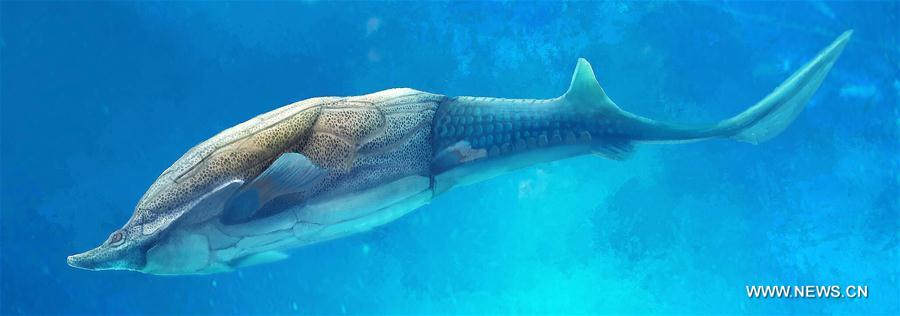
This illustration shows Qilinyu, a 423-million-year-old fish from the Kuanti Formation (late Ludlow, Silurian). Paleontologists from China and Sweden said Thursday that our jaws can be traced back to these extinct armored prehistoric fish that dominated the oceans, rivers and lakes over 400 million years ago. The findings, published in the U.S. journal Science, were based on a newly discovered fossil fish in Yunnan, southwest China, known as Qilinyu, which is part of the ancient armored fish. (Xinhua)
WASHINGTON, Oct. 20 (Xinhua) -- You may never hear anything about placoderms, but palaeontologists from China and Sweden said Thursday that our jaws can be traced back to these extinct armored prehistoric fish that dominated the oceans, rivers and lakes over 400 million years ago.
The findings, published in the U.S. journal Science, were based on a newly discovered fossil fish in Yunnan, southwest China, known as Qilinyu, which is part of the ancient armored fish.
The discovery of the 423-million-year-old fish fossil "fills a big gap in our understanding of how vertebrate jaws evolved," John Long, an paleontologist at Australia's Flinders University, wrote in an accompanying article in the journal.
The question of where our jaws came from is "more complicated than it seems, because not all jaws are the same," Zhu Min of the Chinese Academy of Sciences said in an email to Xinhua.
All modern vertebrates, including us, have a jaw that is composed of three parts: the dentary, maxilla and premaxilla.
But further back in time, only one other group of fishes, the extinct placoderms, have a similar set of jaw bones.
These bones, known as "gnathal plates," have always been regarded as unrelated to our jaw.
"For one thing, they are located slightly further inside the mouth, and in any case the general opinion has been that placoderms and bony fishes are only very distantly related," Zhu said.
The picture began to change in 2013 when Zhu and his colleagues unveiled a fossil, called Entelognathus, that had a placoderm-like body but a three-part jaw, in Yunnan.
"Together with the discovery of placoderm-like characteristics in some of the earliest bony fishes, this began to build a strong case for a close relationship between placoderms and bony fishes," he said.
However, there was some uncertainty as to whether those jaws came from.
Now, Zhu and Per Ahlberg from the Uppsala University in Sweden reported the discovery of Qilinyu that came from the same place and time period as Entelognathus,
The preserved part of the fossil is 126 millimeters in length, with an estimated total body length of more than 20 centimeters.
With a dolphin-shaped head, this fish appears to have dwelled and fed along the bottom of bodies of water.
What's more, it also combines a placoderm skeleton with dentary, maxilla and premaxilla, though the two fishes otherwise look quite different and must have had different lifestyles.
"Looking at the jaw bones of Entelognathus and Qilinyu we can see that they, in both fishes, combine characters of the bony fish jaw bones and placoderm gnathal plates," said Zhu.
"Another thing becomes apparent as well: it has been argued that placoderm gnathal plates represent an inner jaw arcade, similar in position to the 'coronoid bones' of bony fishes, and if that were true we would expect to find gnathal plates just inside of the dentary, maxilla and premaxilla of Entelognathus and Qilinyu; but there is nothing there."
The simplest interpretation of the observed pattern, according to the researchers, is that our own jaw bones evolved from these old gnathal plates of placoderms.
"It seems like substantial parts of our anatomy can be traced back, not only to the earliest bony fishes, but beyond them to the strange ungainly armoured placoderms of the Silurian period (443 to 419 million years ago)," Zhu said.
"Placoderms, a group of extinct armored fishes, long held little or no interest to evolutionary biologists," Long wrote in his comments.
"However, discoveries from China are changing that by showing how important placoderms are to understanding the early assembly of the vertebrate body plan."










